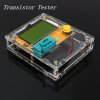Serge 125
Member
Hi all
Ok I have this little electronic checking gadget that you can get from China (see photo) and when I check my N-E-Mosfet I get these values BUT when I look at the data sheet I don't see the values that the little gadget gives. For example; The N-E-Mosfet that I have gives these 2 readings on the gadget 1; C = 4.61 NF 2; VT = 3.1 V . Now when I look at the data sheet I don't see C and VT and even NF. So what must I look for on a data sheet with this gadget values?? THANKS!!
Ok I have this little electronic checking gadget that you can get from China (see photo) and when I check my N-E-Mosfet I get these values BUT when I look at the data sheet I don't see the values that the little gadget gives. For example; The N-E-Mosfet that I have gives these 2 readings on the gadget 1; C = 4.61 NF 2; VT = 3.1 V . Now when I look at the data sheet I don't see C and VT and even NF. So what must I look for on a data sheet with this gadget values?? THANKS!!


